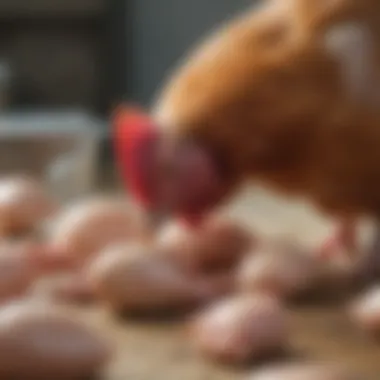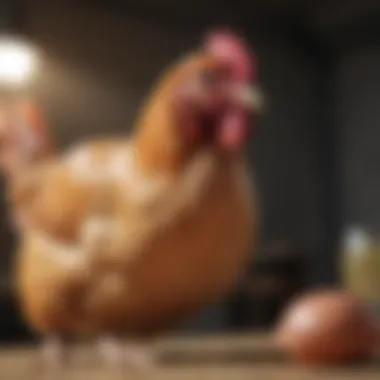Is Raw Chicken Safe for Dogs? A Comprehensive Analysis


Intro
Feeding dogs is a topic that garners significant attention from pet owners, nutritionists, and veterinarians alike. One specific area of interest is the practice of feeding raw chicken. It is known that this practice can offer various nutritional benefits, but it also comes with its own set of risks. Understanding these aspects helps pet owners make the best decisions for their furry companions.
This article will delve into the safety of feeding raw chicken to dogs, examining nutritional needs, potential health hazards, and insights from experts in the field. We will discuss how factors such as dog breeds, age, and size play a role in dietary choices, alongside safe handling practices to prevent foodborne illnesses. Recognizing the implications of pet nutrition is essential for responsible pet ownership, helping ensure that canine companions thrive.
Pet Care Essentials
Daily Nutrition Requirements
Providing adequate nutrition is vital for canines. Dogs require a balance of proteins, fats, carbohydrates, vitamins, and minerals to maintain optimal health. Raw chicken can be a significant protein source, offering essential amino acids that support muscle development, energy, and overall well-being. However, there is a need to balance this with other nutrients since feeding solely raw chicken may not fulfill their complete dietary requirements.
Exercise and Playtime
A nutritious diet goes hand-in-hand with regular exercise. Dogs need daily physical activity tailored to their age, breed, and health status. Activities such as walking, running, or playing fetch are essential to maintain their physical condition while supporting their mental health. Incorporating structured exercise routines can help prevent obesity and related health issues, ensuring that dogs stay active and engaged.
Grooming Tips
While feeding practices are important, maintaining a dog's overall hygiene should not be overlooked. Regular grooming helps keep a dog's coat healthy and can prevent skin issues. Dogs that consume raw diets may need more frequent baths to manage their coat's oiliness or prevent odors. Be sure to brush your dog regularly to minimize shedding and matting of fur, which can cause discomfort and skin irritation.
Health and Wellness Check-ins
Regular veterinary check-ups are essential for monitoring a dog's health, especially when their diet includes raw elements. Vets can provide guidance on nutritional needs and may perform wellness exams to identify any health issues early on. Utilizing preventive care measures will contribute immensely to a dog's well-being.
Finale
Preface to Raw Feeding
Raw feeding has become a subject of significant interest among dog owners in recent years. The concept revolves around providing canine companions with unprocessed, raw animal foods, which proponents believe align more closely with a dog's evolutionary diet. The aim of this section is to highlight why understanding raw feeding is critical for responsible pet ownership.
Feeding raw chicken to dogs is one of the most discussed aspects of this approach. While the potential benefits can be enticing—such as improved coat condition, increased energy levels, and better dental health—there are important considerations and risks to keep in mind. These include the need for a balanced diet, proper food handling procedures, and ongoing assessments of a dog's health. The raw feeding trend requires dog owners to educate themselves thoroughly to make informed decisions.
Understanding Raw Diets
Raw diets often consist of meats, bones, fruits, and vegetables. The idea is to mimic the natural diet of dogs in the wild, which traditionally encompasses whole prey. The dietary components of raw feeding can vary significantly among different enthusiasts and nutritionists.
Some common elements of raw diets include:
- Meat: This forms the core of the diet. Muscle meat from commercially available sources and raw chicken are commonly used.
- Organs: These are essential for providing vital nutrients, such as liver and heart.
- Bones: Raw meaty bones may contribute to calcium intake and improve dental hygiene.
- Vegetables: These can offer additional nutrients and fiber, but should be processed for better digestion.
Ultimately, a well-balanced raw diet must consider nutritional needs and avoid deficiencies or excesses.
Trends in Dog Nutrition
As dog owners have become increasingly conscious of pet nutrition, the trends in feeding have shifted dramatically. There is a growing interest not only in raw diets but also in holistic, natural, and functional foods. The raw food movement has influenced many products appearing in commercial pet food aisles.
Some notable trends include:
- The rise of premade raw diets, which save time for pet owners and provide convenient options.
- An emphasis on transparency in ingredients, as consumers become more aware of what goes into their pet's food.
- The integration of superfoods, like blueberries and kale, into dog diets, aimed at maximizing health benefits.
The ongoing evolution in dog nutrition reflects a broader understanding of animal health and wellbeing. As a result, pet owners are empowered to make conscious choices tailored to their dog’s specific needs.
"Understanding the fundamental aspects of dog nutrition is vital for responsible feeding practices, especially when considering raw diets."
In summary, raw feeding evokes both support and skepticism. It is essential for dog owners to be informed about the implications and requirements involved in feeding raw chicken, ensuring their pets thrive.
Nutritional Aspects of Raw Chicken
The nutritional aspects of raw chicken are crucial in determining its viability as a food option for dogs. Understanding these elements helps pet owners make informed decisions regarding their dog’s diet. Raw chicken offers several benefits, including high-quality protein and essential nutrients that may contribute to a well-rounded diet. Yet, it also poses some challenges that need careful consideration.
Protein Content
Protein is a fundamental building block for any dog's diet. Raw chicken, being a natural source of protein, is often praised for its high protein content. Specifically, chicken meat contains approximately 20-25% protein. This level is critical for muscle maintenance, immune function, and overall energy levels in dogs. Inadequate protein intake can lead to various health issues, including muscle wasting and weakened immunity.


Moreover, the protein in raw chicken is considered highly digestible, which means dogs can easily absorb and utilize it. This digestibility can be particularly beneficial for active dogs or those with higher protein needs, such as working breeds or young dogs that are still growing.
When integrating raw chicken into a dog's diet, it is important to ensure protein from other sources complements raw chicken. A diverse protein intake can lead to a more balanced diet, ensuring that all amino acids required for different bodily functions are met. However, relying solely on raw chicken may not provide all necessary amino acids, so pet owners should introduce different protein sources gradually.
Essential Nutrients
In addition to protein, raw chicken can provide essential nutrients that support a dog's overall health. Some of these nutrients include:
- B vitamins: These are important for energy metabolism and can help maintain a dog's skin and coat health.
- Fatty acids: Raw chicken contains healthy fats that promote skin health and maintain a shiny coat. However, the fat content can vary, so balancing it with other foods is essential.
- Minerals: Chicken meat, especially if fed with bones, can be a source of calcium and phosphorus. These minerals are vital for bone health and development in dogs.
Nevertheless, there are potential downsides to consider. While raw chicken can be rich in nutrients, feeding only chicken can lead to nutritional imbalances. For instance, a chronic lack in vitamin A or a surplus of certain minerals can lead to health complications. It is important that chicken is part of a varied diet that includes vegetables and other protein sources.
Nutritional balance is key in a dog’s diet—exclusively feeding raw chicken can lead to deficiencies or excesses of certain nutrients.
Health Risks Associated with Raw Chicken
The notion of feeding raw chicken to dogs has gained significant attention in recent years. However, it is crucial to understand the potential health risks that accompany this practice. Awareness of these risks can guide pet owners in making informed decisions about their dogs' diets. This section elaborates on the key health concerns, specifically surrounding bacterial infections and nutritional imbalances, which are vital aspects for every dog owner to consider.
Bacterial Infections
Salmonella
Salmonella is a type of bacteria that can be found in raw chicken. Its significance in this article is highlighted by the potential health risks it poses to both dogs and their human companions. The key characteristic of Salmonella is its ability to cause serious gastrointestinal illness when ingested. This makes it essential for discussion, as undercooked or contaminated chicken can lead to salmonellosis in dogs.
The unique feature of Salmonella is its prevalence; it is a common source of foodborne illness. The advantages for this article include the need to make pet owners aware of how easily dogs can contract this infection. Understanding the risks allows more focused discussions on preventive measures. Therefore, awareness about Salmonella guides pet owners in proper handling of raw chicken to reduce the chance of infection.
Campylobacter
Campylobacter is another bacterium associated with raw chicken consumption. This pathogen is significant for broader discussions on the health risks of feeding raw diets to dogs. The key characteristic of Campylobacter is its association with gastrointestinal diseases. The bacteria can lead to severe diarrhea, vomiting, and abdominal pain in an infected dog. Its impact is particularly dangerous for young, old, or immunocompromised dogs.
The unique feature of Campylobacter lies in its resilience; it can survive in various environmental conditions. For pet owners, the main takeaway is understanding the seriousness of potential infections. The disadvantages of feeding raw chicken include the risk of transmitting Campylobacter to humans as well, which raises public health concerns. This compounded risk emphasizes the importance of safe handling and cooking practices.
Nutritional Imbalance
Calcium Deficiency
Calcium deficiency is a notable health risk linked to feeding raw chicken exclusively to dogs. This issue arises when the diet lacks sufficient calcium to meet a dog's needs. The balance of nutrients is essential for a dog's health, and excluding critical minerals can lead to health complications. The significance of this topic in the article highlights the importance of a balanced diet.
The key characteristic of calcium deficiency is its effect on bone health. Insufficient calcium can lead to weak bones or developmental issues, especially in growing puppies. This concern is crucial since it draws attention to the necessity for a well-rounded diet among raw feeders. Without proper supplementation or varied diets, a dog may face serious health issues in the long term.
Vitamin Overload
Vitamin overload is another risk that can arise from feeding a diet high in raw chicken without proper supervision. This unique aspect underscores the potential of certain vitamins building up to toxic levels. For instance, an excess of vitamin A can lead to toxicity symptoms in dogs, affecting their health.
The importance of discussing vitamin overload in the context of this article cannot be overlooked. Over-supplementation can result from a misunderstanding of a dog’s nutritional requirements. Therefore, pet owners should be cognizant of how not all dog diets are one-size-fits-all. Monitoring the vitamin intake is crucial to ensuring a healthy balance.
In summary, the discussion on health risks associated with raw chicken is pertinent for all dog owners. Understanding bacterial infections and nutritional imbalances provides a framework for safe feeding practices.
Factors Influencing Safety
When discussing the safety of feeding raw chicken to dogs, it is crucial to consider various factors that can influence outcomes. Each dog's unique characteristics, such as breed, age, and health, can significantly impact how they respond to a raw chicken diet. Understanding these influences helps pet owners make informed decisions that align with their dog’s specific needs and conditions.
Dog Breed Considerations
Different dog breeds can have varying tolerances and nutritional requirements. Some breeds are more robust and adaptable than others. For example, larger breeds like the German Shepherd or Labrador Retriever may handle raw chicken more effectively than small breeds such as Chihuahuas. The digestive system varies among these breeds, affecting how they break down raw proteins and bacteria.
Additionally, certain breeds are prone to specific health issues that may be exacerbated by a raw diet. For instance, breeds with sensitive stomachs, such as the Boxer or Bulldog, may experience gastrointestinal upset when fed raw chicken. Therefore, it is critical for dog owners to consult with a veterinarian before introducing raw chicken, especially if their pet belongs to a breed with known sensitivities.
Age and Health Conditions
The age of a dog also plays a significant role in dietary safety. Puppies, adults, and senior dogs have different nutritional needs and digestive capabilities. Puppies are still developing their immune systems, making them more susceptible to pathogens found in raw chicken. Therefore, feeding raw diets to puppies without proper supervision and guidance from a veterinarian is generally advised against.
On the other hand, senior dogs may have compromised immune systems or underlying health issues that could make consuming raw chicken risky. Health conditions such as pancreatitis, liver disease, or diabetes require specific dietary considerations. In these cases, the potential for adverse reactions is heightened. Pet owners should assess their dog's health status thoroughly and consider linking with professionals who guide them about raw feeding.
"Understanding breed differences and age-related concerns is crucial when evaluating the safety of dog diets."


Raw Chicken Preparation and Handling
The safety and health of dogs consuming raw chicken significantly rely on preparation and handling practices. Raw chicken can harbor pathogens that pose risks to both pets and their owners. Therefore, understanding proper preparation methods is crucial to minimizing these risks. This section outlines essential practices related to cleaning, sanitizing, and storage.
Cleaning and Sanitizing
The first step in raw chicken preparation involves thorough cleaning. Before handling the raw meat, ensure that hands are washed with soap and water. This eliminates bacteria that may transfer from your hands to the food. The work surfaces, utensils, and cutting boards must also be cleaned with disinfectants after contact with raw chicken.
Failure to clean could lead to cross-contamination, where bacteria from raw meat contaminates other foods or surfaces. It is advisable to use separate cutting boards—one for raw chicken and another for fruits or vegetables. This practice not only safeguards the pet but also the family.
Proper sanitization is a non-negotiable step in safe raw feeding.
Safe Storage Practices
Once chicken is cleaned and ready for preparation, proper storage becomes paramount. Raw chicken should be stored at appropriate temperatures to prevent bacterial growth. It is crucial to refrigerate raw chicken at or below 40°F (4°C). If not used within a few days, freezing the chicken is advisable. Freezing paathens can minimize bacterial hazards for a more extended period while maintaining the nutritional quality of the meat.
When thawing frozen chicken, always do so in the refrigerator, avoiding room temperature. If the meat is thawed in warm conditions, this increases the risk of pathogen growth, countering all the prior precautions made.
In summary, effective cleaning and safe storage practices are essential when handling raw chicken for dogs. Simplifying the process can lead to a healthier pet and a safer household environment. Proper hygiene habits go a long way in fortifying the argument for responsible pet care.
Expert Opinions on Raw Feeding
The topic of raw feeding for dogs is widely debated. It's important to consider expert opinions as they provide insights based on research and practical experiences. Veterinary perspectives, along with insights from pet nutritionists, can help pet owners make informed decisions. Having a diverse set of views can assist in understanding the nuanced benefits and potential issues related to raw chicken in a dog's diet.
Veterinary Perspectives
Veterinarians often express caution when it comes to raw feeding. They recognize the potential risks associated with raw chicken, particularly concerning bacterial infections like Salmonella and Campylobacter. These are significant health threats that can affect both dogs and humans. Vets emphasize the importance of safe practices when handling raw food. Additionally, they discuss the need for balanced nutrition to prevent deficiencies or excesses in a dog's diet.
Many veterinarians stress that a well-formulated commercial dog food is typically more reliable in terms of nutritional adequacy and safety. They often encourage using food that has been scientifically formulated to meet the needs of dogs. This approach can avoid the risks linked to raw feeding while ensuring that dogs receive all necessary nutrients. However, some veterinarians acknowledge that raw diets can benefit certain dogs, especially those with allergies or intolerances to specific ingredients found in commercial foods.
Trends Among Pet Nutritionists
Pet nutritionists offer another perspective on raw feeding. They often support the concept of feeding raw, particularly citing the natural instincts of dogs as carnivores. They argue that a fresh and unprocessed diet can lead to better coat condition, improved energy levels, and healthier weight management. Nutritionists usually emphasize the significance of biodiversity in a dog's diet, suggesting a variety of proteins, including raw chicken.
Some nutritionists recommend consulting with a specialist when introducing raw diets. They might suggest a transition period where cooked and raw options are combined initially. This helps dogs adapt and allows for the monitoring of any health changes. However, they also underline the need for proper handling and sourcing of raw chicken to minimize health risks.
Many pet nutritionists advocate for the use of supplemental nutrients to help balance the diet.
In summary, examining expert opinions on raw feeding sheds light on the complexities involved. Furthermore, it highlights the need for a balanced approach that considers both the potential benefits and risks. Keeping an open dialogue with veterinary professionals and nutritionists can guide pet owners in making safe dietary choices for their dogs.
Case Studies and Anecdotal Evidence
Case studies and anecdotal evidence play a significant role in the ongoing debate surrounding the safety of feeding raw chicken to dogs. Personal testimonies from dog owners and findings from small-scale studies can provide valuable insight into the actual outcomes of raw feeding practices. These perspectives allow pet owners to assess the broader implications of raw diets based on real-world experiences, rather than solely relying on theoretical knowledge or expert guidelines. This section will explore positive outcomes and negative experiences associated with feeding raw chicken to dogs, thus presenting a holistic view of the practice.
Positive Outcomes
Proponents of feeding raw chicken to dogs often cite numerous positive health outcomes. Some of these outcomes include:
- Improved Coat Quality: Many dog owners report that their pets' fur becomes shinier and healthier when switched to a raw diet. The omega fatty acids in chicken can contribute to this change.
- Increased Energy Levels: There are claims that dogs on raw diets exhibit higher energy and vitality. Owners often mention their dogs are more playful and active.
- Better Digestion: Anecdotal evidence suggests improved digestion in dogs that consume raw chicken. Some owners notice that their dogs have firmer stools and less gastrointestinal discomfort.
- Weight Management: Certain owners note that raw feeding has helped their dogs maintain a healthy weight, as they can adjust portions based on individual needs without filler ingredients common in many commercial dog foods.
Negative Experiences
On the other hand, negative experiences related to feeding raw chicken should not be overlooked. Some common concerns raised by dog owners include:
- Health Risks from Infections: A significant number of pet owners have reported illnesses in their dogs after consuming raw chicken.
- Behavioral Changes: In some cases, dog owners have observed changes in behavior, such as increased aggression or anxiety, attributed to the protein-rich raw diet.
- Nutritional Imbalances: Some owners face challenges with maintaining a balanced diet when relying solely on raw feeding. Insufficient calcium or essential vitamins can lead to health issues in pets.
- Joint Issues: Another concern is related to feeding raw chicken bones, particularly those that are not raw. Some dogs have suffered from dental and digestive problems due to bone fragments causing blockages or fractures.
- This includes bacterial infections like Salmonella and Campylobacter, which can pose severe health risks to both dogs and humans if not properly managed.
These anecdotes illustrate that not all experiences with raw chicken are positive. Pet owners should weigh these potential risks against the benefits, ensuring they are informed about both sides of the discussion before making decisions regarding their dog's diet.
Alternative Diets to Consider
Evaluating the safety of feeding raw chicken is only one aspect of the broader conversation about canine nutrition. Pet owners should explore alternative diets that provide balanced nutrition while minimizing health risks. Diverse dietary options underscore the importance of understanding the nutritional needs of dogs. A one-size-fits-all approach often does not yield optimal health outcomes. This section delves into two notable alternatives: commercial raw diets and cooked chicken options.
Commercial Raw Diets


Commercial raw diets have risen in popularity in recent years. These are pre-packaged raw food products specifically formulated for dogs. A sgnificant advantage of these diets is their nutritional completeness. Reputable brands often include a variety of meat sources, organs, and bone, ensuring a balanced profile. Moreover, these products often undergo testing to reduce risk of pathogens such as Salmonella or Campylobacter.
However, it is essential to read labels carefully. Ingredients can vary wildly between brands. Some may offer higher protein content while others may focus on supplementation with vitamins or minerals. It's also crucial for owners to consider any specific health issues their dogs may have before choosing a brand. Some dogs with certain health conditions may react poorly to raw proteins. Flexibility in choosing brands can create unique challenges and confusion for the pet owner.
In summary, while commercial raw diets simplify the raw feeding process, one must be diligent about brand selection and ingredient scrutiny. A balance of variety and quality in choosing these diets can lead to healthier outcomes for dogs.
Cooked Chicken Options
Cooked chicken present a safer option for many pet owners concerned about the risks associated with feeding raw diets. This method eliminates most bacterial pathogens. Cooking can also enhance digestibility, making nutrients more accessible for dogs. Additionally, it can appeal to picky eaters.
When preparing cooked chicken for dogs, several considerations are vital:
- Skin Removal: Fatty skin can lead to obesity or pancreatitis in some dogs. Skinned chicken is often a better choice.
- Seasonings Avoidance: Dogs should not consume common seasonings like garlic or onion, as these can be toxic to them.
- Bone Safety: Avoid cooking bones as they can splinter, presenting a choking hazard or causing internal injury.
While cooked chicken is a great protein source, it should not be the sole diet. It lacks essential nutrients that may be found in a more balanced, specifically formulated diet. Owners must consider adding diversity to their canine’s meals, such as vegetables or grains, as long as these are dog-safe.
"Providing your dog with a balanced diet is fundamental to their overall well-being."
By exploring these alternatives, pet owners can make informed decisions tailored to their dogs' specific needs.
Legal Considerations
The sector of raw feeding for dogs, particularly when focusing on raw chicken, is intertwined with various legal considerations. Pet owners or caregivers need to be acutely aware of the regulatory framework within their jurisdiction concerning raw pet food. This section elucidates the legal parameters surrounding raw diets, emphasizing the importance of compliance with regulations that govern pet food safety and liability.
Understanding these laws is not just about following rules; it has significant implications for the health of dogs and the legal responsibilities of pet owners. Non-compliance with regulations can lead to serious health risks for pets and substantial legal repercussions for their owners.
Furthermore, being informed about legalities empowers pet owners to make informed decisions regarding their pets’ diet, ultimately leading to healthier outcomes for their canine companions.
Regulations on Raw Pet Food
In many countries, the production and sale of raw pet food are subject to specific regulations. These laws aim to ensure the safety and nutritional adequacy of the food provided to pets. For instance, in the United States, the Food and Drug Administration (FDA) provides guidelines for the manufacturing, distributing, and selling of pet food. These regulations often require raw food products to meet certain safety standards to minimize risks associated with pathogens.
The regulations can vary significantly between regions. In some places, raw pet food may need to undergo specific testing for contaminants such as Salmonella or E. coli before being sold. It is crucial for pet owners to familiarize themselves with the legal specifications applicable in their area.
Additionally, some states impose restrictions on the types of ingredients that can be included in raw diets. These laws could dictate which animal parts are legal to include, and they may also require that brands produce their food in inspected facilities.
Liability Issues for Pet Owners
Feeding raw chicken to dogs also carries liability risks for pet owners. If a pet becomes ill after consuming raw chicken, owners can face legal consequences depending on local laws. If it is proven that the food was contaminated or that necessary precautions in preparation and storage were not taken, the pet owner might be held liable for any resulting health issues.
Moreover, if a dog causes harm to another person or animal after consuming raw food that has not been handled properly, the owner may be subject to civil liability as well. Insurance policies may not cover incidents arising from improper feeding practices or non-compliance with health standards.
Pet owners need robust education regarding safe food handling practices. They should document their practices of food sourcing, preparation, and feeding to help mitigate potential liability issues. Regular consultations with veterinarians can play a pivotal role in ensuring that pet owners remain informed about both their legal responsibilities and best practices in pet nutrition.
"Understanding and adhering to pet food regulations is crucial not just for the health of pets but also to avoid legal troubles for owners."
In summary, a grasp of the legal considerations surrounding the feeding of raw chicken to dogs is paramount for responsible pet ownership. This knowledge equips pet owners to navigate potential risks effectively.
Closure: Informed Decision Making
In the realm of canine nutrition, the decision on whether to feed raw chicken to dogs necessitates a well-informed approach. This article has traversed the landscape of raw feeding, laying out various aspects that pet owners must consider. The potential benefits, risks, and expert insights provide a framework for making sound decisions. Feeding raw food can yield nutritional advantages, but it also brings forth significant health concerns that require serious reflection.
Pet owners must not only balance the nutritional benefits of raw chicken but also stay vigilant about the health risks it can entail. Understanding the fundamental elements of a dog's health, including their breed, age, and pre-existing medical conditions, is critical. The handling and preparation of raw chicken introduce another layer of complexities. Proper cleaning, sanitization, and storage practices are imperative for minimizing risks of bacterial infections.
Ultimately, the responsibility lies with the pet owner to make informed choices. Knowledge is power, and by understanding the advantages and disadvantages of raw chicken as part of a dog's diet, owners can safeguard their pet's health. A thoughtful approach enhances the likelihood of maintaining a balanced, safe, and nutritious diet for beloved companions.
“An informed decision is the bedrock of responsible pet ownership.”
Summary of Key Points
Throughout this article, several key points have emerged:
- Nutritional Benefits: Raw chicken is rich in protein and essential nutrients, valuable for a dog's dietary needs.
- Health Risks: Significant risks, such as bacterial infections like Salmonella and Campylobacter, are associated with raw chicken.
- Safety Handling: Proper food handling techniques are crucial to mitigate health risks.
- Individual Considerations: Dogs’ specific characteristics, including breed, age, and health condition, play a vital role in decision making.
- Expert Guidance: Consulting veterinary and nutrition professionals can provide tailored advice.
Final Recommendations
After considering the various aspects of feeding raw chicken to dogs, several recommendations emerge:
- Consult a Veterinarian: Pet owners should seek professional advice before making dietary changes, especially regarding raw diets.
- Research Thoroughly: Understanding both the benefits and risks associated with raw feeding is essential for informed choices.
- Implement Safety Practices: Proper preparation, storage, and handling of raw chicken can reduce the risk of contamination.
- Monitor Dog's Health: Regularly assessing the dog’s health and response to dietary changes is vital for ensuring well-being.
- Consider Alternative Diets: Explore commercial raw diets or cooked chicken options as safer alternatives if concerns persist.
By approaching raw feeding with care and knowledge, pet owners can make decisions that not only align with nutritional ideals but also prioritize the safety and health of their dogs.







